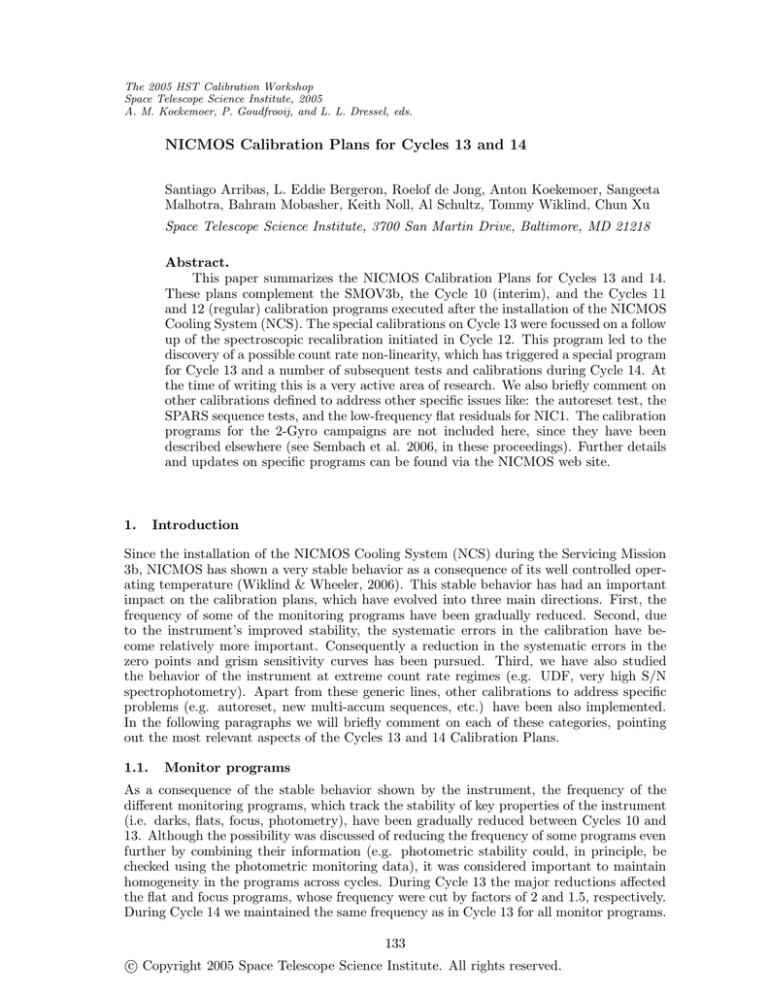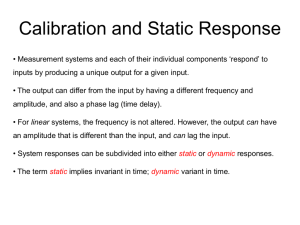
The 2005 HST Calibration Workshop
Space Telescope Science Institute, 2005
A. M. Koekemoer, P. Goudfrooij, and L. L. Dressel, eds.
NICMOS Calibration Plans for Cycles 13 and 14
Santiago Arribas, L. Eddie Bergeron, Roelof de Jong, Anton Koekemoer, Sangeeta
Malhotra, Bahram Mobasher, Keith Noll, Al Schultz, Tommy Wiklind, Chun Xu
Space Telescope Science Institute, 3700 San Martin Drive, Baltimore, MD 21218
Abstract.
This paper summarizes the NICMOS Calibration Plans for Cycles 13 and 14.
These plans complement the SMOV3b, the Cycle 10 (interim), and the Cycles 11
and 12 (regular) calibration programs executed after the installation of the NICMOS
Cooling System (NCS). The special calibrations on Cycle 13 were focussed on a follow
up of the spectroscopic recalibration initiated in Cycle 12. This program led to the
discovery of a possible count rate non-linearity, which has triggered a special program
for Cycle 13 and a number of subsequent tests and calibrations during Cycle 14. At
the time of writing this is a very active area of research. We also briefly comment on
other calibrations defined to address other specific issues like: the autoreset test, the
SPARS sequence tests, and the low-frequency flat residuals for NIC1. The calibration
programs for the 2-Gyro campaigns are not included here, since they have been
described elsewhere (see Sembach et al. 2006, in these proceedings). Further details
and updates on specific programs can be found via the NICMOS web site.
1.
Introduction
Since the installation of the NICMOS Cooling System (NCS) during the Servicing Mission
3b, NICMOS has shown a very stable behavior as a consequence of its well controlled operating temperature (Wiklind & Wheeler, 2006). This stable behavior has had an important
impact on the calibration plans, which have evolved into three main directions. First, the
frequency of some of the monitoring programs have been gradually reduced. Second, due
to the instrument’s improved stability, the systematic errors in the calibration have become relatively more important. Consequently a reduction in the systematic errors in the
zero points and grism sensitivity curves has been pursued. Third, we have also studied
the behavior of the instrument at extreme count rate regimes (e.g. UDF, very high S/N
spectrophotometry). Apart from these generic lines, other calibrations to address specific
problems (e.g. autoreset, new multi-accum sequences, etc.) have been also implemented.
In the following paragraphs we will briefly comment on each of these categories, pointing
out the most relevant aspects of the Cycles 13 and 14 Calibration Plans.
1.1.
Monitor programs
As a consequence of the stable behavior shown by the instrument, the frequency of the
different monitoring programs, which track the stability of key properties of the instrument
(i.e. darks, flats, focus, photometry), have been gradually reduced between Cycles 10 and
13. Although the possibility was discussed of reducing the frequency of some programs even
further by combining their information (e.g. photometric stability could, in principle, be
checked using the photometric monitoring data), it was considered important to maintain
homogeneity in the programs across cycles. During Cycle 13 the major reductions affected
the flat and focus programs, whose frequency were cut by factors of 2 and 1.5, respectively.
During Cycle 14 we maintained the same frequency as in Cycle 13 for all monitor programs.
133
c Copyright 2005 Space Telescope Science Institute. All rights reserved.
134
Arribas et al.
However, the change to 2 Gyro operating mode for HST has reduced the visibility period
of some of the objects traditionally used for some of these programs, like the photometric
and focus monitor. Consequently we have added new objects to these programs (G191B2B
as a new photometric standard and 47Tuc as a new focussing cluster).
1.2.
Photometric and Spectrophotometric recalibrations
The more stable behavior of the detectors has led to the systematic errors playing a relatively
more important role in limiting the actual accuracy of standard observations. Consequently
we launched in Cycle 12 two programs (photometric and spectrophotometric re-calibrations)
aimed at improving the systematic errors associated with the photometric zero-points and
sensitivity curves with respect to those achieved during Cycle 7 and 7N. The photometric
re-calibration expanded the number and type of stars used for obtaining the zero points
for all filters. Similarly, the spectroscopic recalibration allowed a reanalysis of the sensitivity curves for the three grisms using a larger number and variety of stars. Several of
the selected objects were common for the two proposals. Therefore, these data allowed
a spectrophotometric recalibration by cross-checking results obtained independently from
these modes (i.e. imaging/filters and spectroscopy/grism). This program (which included
new faint calibrating stars) has led to the discovery of a possible count rate non-linearity.
This effect, the so called ‘Bohlin effect’, is described in detail in Bohlin, Lindler, & Riess
(2005). As a response to this effect, a special calibration program was implemented in
Cycle 13, and several tests and calibrations have followed during Cycle 14. This effect is
dependent on the count rate and thus affects observations in a source-dependent way, as we
briefly describe below. The new data obtained with the photometric re-calibration program
(as well as the larger set of data collected with the photometric monitoring programs) also
suggested the possibility of some systematic residual associated with the position of the
object in the field of view. During Cycles 7 and 7N the possible variation of the response
(after flat-fielding) as a function of the position in the field of view was estimated to be
small compared with the actual uncertainties in the photometry. However, with the current
higher precision data this is unclear, and a study to analyze the low frequency flat residuals
has been implemented in the Cycle 14 Calibration Plan. This will be done initially for
camera 1 since the intra-pixel sensitivity effect on the photometry is smaller. Depending
on the results of this program a similar one could be also implemented for cameras 2 and 3
(which require extensive dithering to average out this effect; Xu & Mobasher, 2003).
1.3.
Calibrating the extremes: From the very high S/N regime to the UDF
During Cycles 12-14 the behavior of NICMOS at extreme count rate regimes has been
investigated. On one hand a Cycle 12 calibration proposal lead by R. Gilliland was aimed
at investigating the relative spectrophotometric accuracy of the instrument in the very high
S/N regime. It was found that NICMOS can reach a relative precision of around 10−4
or even higher in time series observations (Gilliland and Arribas 2003). Further details
can be found in Gilliland (2006). In the other extreme, the Hubble Ultra Deep Field
observations imposed new calibration challenges. Details on these particular calibrations are
discussed in Mobasher & Riess (2005) and Thompson (2006). Because objects in the UDF
are observed at extremely low count rates (i.e. very different to those typical of standard
stars observations), their calibration may be affected by the ‘Bohlin effect’ mentioned above.
In order to understand better the origin of this reported non-linearity, a program which
includes several tests has been implemented in the Cycle 14 Calibration Plan. These tests
are: i) the measurement of the wavelength dependence of the persistence decay after an
exposure of a bright star in a series of multi-accum dark frames, ii) the measure of the
non-linearity dependence on the count rate by observing a field of stars in a sequence
of lamp off/on, and so artificially increasing the background level (this will be done in
imaging and grism modes), and iii) the photometric measurements of the faint standard stars
NICMOS Calibration Plans for Cycles 13 and 14
135
SNAP-2 and WD1657+343 (on which the NICMOS non-linearity was originally discovered
using grism observations) will be repeated to obtain higher S/N. All these observations
should clarify the origin of the non-linearity effect, and its possible relation with the UDF
calibrations (de Jong 2006).
1.4.
Specific calibrations
Other programs implemented in the calibration plans addressed more specific issues like:
i) Delta-T program: The goal of this program was to study the effects of the detector
temperature on the darks. (This was a Cycle 12 calibration program implemented too late
to be included in the standard calibration plan for this cycle).
ii) Autoreset test: This Cycle 13 calibration program is aimed at testing the short term
temperature ripples in the NICMOS dewar.
iii) New SPARS sequences: This Cycle 14 program had the goal of testing the darks of
the newly implemented SPARS multiaccum sequences.
Further details on the individual proposals may be found in the table below (see also
Arribas et al. 2005), and via the standard HST and NICMOS web sites.
Acknowledgments. Thanks are due to Ralph Bohlin, Ron Gilliland, Dean Hines,
Marcia Rieke, Adam Riess, Glenn Schneider and Rodger Thompson for their contributions
to the recalibration of NICMOS after the installation of NCS.
References
Arribas, S. et al.. 2005, Instrument Science Report NICMOS 2005-005 (Baltimore: STScI),
available through http://www.stsci.edu/hst/nicmos
Bohlin, R., Lindler, R., & Riess, A. 2005, Instrument Science Report NICMOS 2005-002
(Baltimore: STScI)
Gilliland, R., & Arribas, S. 2003, Instrument Science Report NICMOS 2005-001
(Baltimore: STScI)
Gilliland, R. 2006, The 2005 HST Calibration Workshop. Eds. A. M. Koekemoer, P.
Goudfrooij, & L. L. Dressel, this volume, 162
de Jong, R. 2006, The 2005 HST Calibration Workshop. Eds. A. M. Koekemoer, P. Goudfrooij, & L. L. Dressel, this volume, 121
Mobasher, B., & Riess, A. 2005, Instrument Science Report NICMOS 2005-003
(Baltimore: STScI)
Sembach, K. et al. 2006, The 2005 HST Calibration Workshop. Eds. A. M. Koekemoer, P.
Goudfrooij, & L. L. Dressel, this volume, 375
Thompson, R. 2006, The 2005 HST Calibration Workshop. Eds. A. M. Koekemoer, P.
Goudfrooij, & L. L. Dressel, this volume, 137
Wiklind, T, & Wheeler, T. 2006, The 2005 HST Calibration Workshop. Eds. A. M. Koekemoer, P. Goudfrooij, & L. L. Dressel, this volume, 169
Xu, C., & Mobasher, B. 2003, Instrument Science Report NICMOS 2003-009
(Baltimore: STScI)
136
Arribas et al.
Table 1: Cycle 13 and Cycle 14 calibration programs. Details on individual programs can
be obtained via the HST-STScI web site at http://www.stsci.edu/hst
Activity title
Multiaccum Darks
ID (Cycle/Program)
10380 (C13), 10723(C14)
Focus Stability
10382 (C13), 10724 (C14)
Photometric Stability
10381 (C13), 10725 (C14)
Flat Fields Stability
10379 (C13), 10728 (C14)
Grism Recalibration: follow up
10383 (C13)
Extreme count rates linearity test
10454 (C13)
Auto-reset test
10465 (C13)
Non-linearity tests
10726 (C14)
Low-frequency flat residuals for NIC1
10727 (C14)
Test for newly implemented SPARS sequences
10721 (C14)
Comments
Monitor programs (monthly). Linear component of the dark current,
shading, ampified glow.
Monitor programs. NIC1 and NIC2
every 45 days. A new field (47Tuc)
added in Cycle 14 to account for
2Gyro operations.
Monitor programs (montly visits).
Same as in previous cycles (i.e. observations of P3003E with selected
broad filters). A new object added
in Cycle 14 to account for 2Gyro
operations.
Monitor programs. Pointed lamp
observations using selected filters.
Special calibration program. Observations of the standard star
BD+17 4708. Led to the discovery of a possible count rate nonlinearity.
Special calibration program. First
response to the discovery of a possible count rate non-linearity.
Special calibration program to test
the short term temperature ripples
in the NICMOS dewar.
Special
calibration
program.
Includes several tests to analyze the count rate dependent
non-linearity seen in NICMOS
spectrophotometry.
Special calibration program to better characterize the flat-field errors
seen for camera 1 in the photometric monitoring data.
Special calibration program to
measure the dark current of the
new multiaccum sequences for the
three NICMOS detectors.




